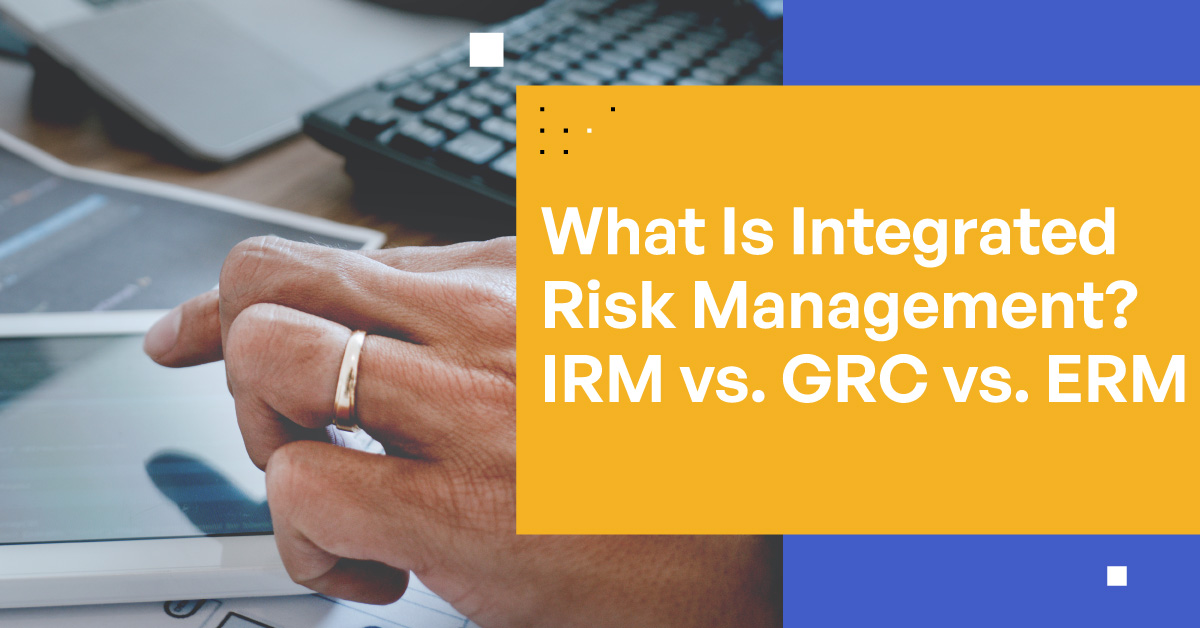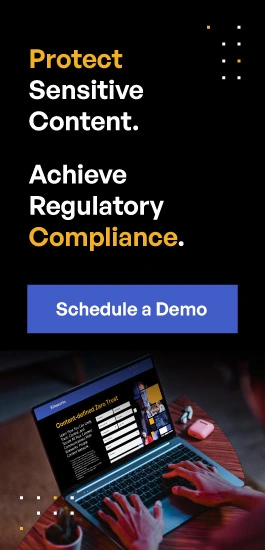What Is Integrated Risk Management? IRM vs. GRC vs. ERM
Why is integrated risk management important? IRM helps a company understand risk as a metric to make more appropriate organizational decisions related to cybersecurity. But how does integrated risk management differ from governance, risk and compliance (GRC)? And what about enterprise risk management (ERM)? Are these the same? Do they differ? How do they differ? In this article, we’ll explore IRM, including what it is and why it’s important, but also how it’s similar and different to these other key risk management concepts.
What Is Integrated Risk Management?
Integrated risk management is a collection of practices, processes, and business goals built around foregrounding risk as a driving factor of cybersecurity and IT administration. In modern cybersecurity and compliance, risk management is critical for successful and responsive system administration. A risk-driven approach to such practices provides organizations with more informed and effective decision-making when it comes to protecting stakeholder data and essential enterprise systems.

Why is risk important? As business and government IT systems become more complex, more intertwined, and more dependent on relationships between organizations and third-party vendors, security issues and potential vulnerabilities can arise in unexpected places. Understanding the landscape of threats against these complex systems is a task far beyond ad hoc assessments of system resources—a fact that has become common knowledge through public cyberattacks.
Risk management provides a framework for assessing these vulnerabilities. Business and IT leadership need to study the security gaps in a system to understand how managing risk aligns with their business goals. Risk assessment requires that an organization’s leadership concretely assess the vulnerabilities in a system, catalog them, and continually monitor the system configurations as vendor risk management relationships change.
A risk-based approach to cybersecurity and compliance provides a guiding light beyond simple checklists for compliance and can serve as the bedrock of a truly effective security apparatus. Integrated management can serve as a critical part of an overall assessment strategy.
Gartner defines IRM as having certain, specific attributes addressing different aspects of risk management:
- Strategy: An organization should have an overall strategy in place to approach risk assessment and system optimization. A strategic approach to risk includes the development of robust and evolving governance, risk, and compliance (GRC) measures.
- Assessment: Cataloging potential risk areas, including the identification, evaluation, and prioritization of risks within a given system.
- Response: Developing response systems for the mitigation and remediation of vulnerabilities as they are identified.
- Communication and Reporting: Implementing business and technical processes to take identified risks, document them, and report them effectively to organization leaders and affected stakeholders.
- Monitoring: Creating processes and procedures to track and monitor vulnerabilities, GRC measures, risk ownership, and compliance.
- Technology: Designing and implementing IRM solutions and architecture. IRM solutions are typically Software-as-a-Service (SaaS) platforms that can combine the aspects listed above into dashboards, monitoring, and metrics.
Why Is Integrated Risk Management Important?
The strategic importance of integrated risk management (IRM) lies in its ability to transform risk from a siloed, reactive concern into a core component of an organization’s strategy.
By embedding a risk-aware mindset across all business units, IRM enables leaders to make proactive, informed decisions. Instead of viewing cybersecurity and compliance as separate checklist activities, an integrated approach uses risk as a common language to prioritize investments, optimize processes, and anticipate threats before they escalate into costly incidents. This creates a more resilient and agile organization capable of navigating an unpredictable business environment.
A robust IRM framework also directly aligns security efforts with overarching business objectives. It helps answer critical questions like, “What is our risk appetite for this new digital initiative?” This ensures that resources are allocated to mitigate the most significant threats to the organization’s goals.
This transparent and comprehensive approach also builds and maintains stakeholder trust. Customers, partners, and regulators gain confidence in an organization that can demonstrate it manages risk effectively, which in turn protects its brand reputation and provides a significant competitive advantage.
What Are the Benefits of Integrated Risk Management?
- Holistic Risk Visibility: IRM breaks down departmental silos to create a single, comprehensive view of risk across the entire organization. This allows leadership to understand the interconnectedness of risks and how a threat in one area might impact others.
- Improved Strategic Decision-Making: With a clear, enterprise-wide understanding of the risk landscape, executives can make faster, more confident strategic decisions. This ensures that business growth and innovation are pursued with a full awareness of the potential risks involved.
- Increased Operational Efficiency: By centralizing risk information and automating workflows with integrated risk solutions, organizations can eliminate redundant risk assessment activities. This frees up valuable resources and reduces the administrative burden on teams.
- Reduced Compliance Costs: An integrated framework allows organizations to map controls to multiple regulations simultaneously. This “test once, comply many” approach streamlines audit preparation and significantly lowers the cost of maintaining compliance.
- Stronger Cybersecurity Posture: IRM promotes a proactive approach to security by focusing on the risks that matter most. This leads to better allocation of security budgets, more effective incident response, and an overall more resilient defense against cyber threats.
What Are the Differences Between IRM and Enterprise Risk Management?
IRM and ERM are methods of evaluating risk within a business. However, both emphasize different aspects of risk.
IRM, specifically, focuses on the technological aspect of risk. As an organization grows, IRM would ground its assessments and policies in the technologies driving that growth. That could be something as simple as a new ecommerce system to expand file sharing or email capabilities under certain compliance regulations.
On the other hand, ERM would study the business impact of expanded risk, and would foreground questions about business decisions in the face of cybersecurity vulnerabilities. Business decisions around growth, scalability, or new technologies would necessarily introduce risk, and ERM would evaluate the relationship between the two.
What Are the Differences Between IRM and Governance, Risk, and Compliance?
There are several commonalities between IRM and governance, risk, and compliance measures. GRC is an overarching approach to critical cybersecurity initiatives that include three core components:
- Governance: Developing policies that define how an organization manages its data, including how it is used, transmitted, stored, and protected.
- Risk: The inherent and introduced risks within a given IT and business system, and how the organization manages it.
- Compliance: How well the organization is adhering to relevant industry and government regulations.
When it comes to managing information, GRC provides an important way to break down silos between data sources and groups within organizations to coordinate across these three critical areas.
One of the clearest differences between these two approaches is that GRC emphasizes data and compliance as an organization. IRM, on the other hand, emphasizes risk as a priority for internal systems. IRM can include governance as an aspect of assessment, but (unlike GRC) it does not foreground governance itself. Instead, governance and compliance are driven by risk.
Integrated risk management is distributed across an entire organization rather than centering on a governance or compliance team. This provides more coverage for assessments, as there is more potential for collaboration and communication regarding potential risks as they emerge in an organization.
Finally, IRM does not align IT management with governance, risk, and compliance but rather the ownership of risk and compliance, as well as independent and thorough audits using targeted assessments as metrics for evaluation.
Enterprise Risk Management (ERM) vs. Governance Risk and Compliance (GRC)
The main difference between enterprise risk management (ERM) and governance, risk, and compliance (GRC) is the scope of their respective activities. Enterprise risk management focuses on risk assessment and management across all business operations and is concerned with understanding, analyzing, and mitigating overall risk to the organization.
GRC, on the other hand, focuses specifically on governance, risk management, and compliance with laws and regulations, both internal and external. It is concerned with ensuring that the organization has effective policies, procedures, and controls in place to detect, prevent, and respond to regulatory compliance violations and risks.
ERM and GRC have similar elements but serve different purposes. ERM is a holistic approach to risk management, while GRC is more focused on regulatory compliance and risk management initiatives.
The Advent of Integrated GRC
Integrated governance, risk, and compliance (GRC) is a process used to manage multiple components of governance, risk, and compliance in a streamlined, systematic approach. It provides a unified view of risks across the organization to help identify and prioritize corrective actions. A successful GRC process also helps organizations to establish consistency in decision-making, optimize resources, and improve communication throughout the organization. It also helps organizations stay compliant with external regulations and internal policies.
What Are the Best Practices for Implementing IRM Frameworks?
Fortunately, while IRM addresses complex IT and business systems, implementing a framework can start as an intuitive self-evaluation practice.
Some of the steps organizations can take to begin implementing an IRM framework include the following:
- Cultivate a Risk-aware Culture: The first step is to make management a centralized part of your security and business processes. This means implementing metrics and policies that directly address the security and privacy risks of existing and evolving IT configurations.
- Align Business Goals, Cyber Strategy, and Compliance: Business goals cannot be distinct from cybersecurity and compliance strategies. Aligning these three aspects of doing business under management not only helps mitigate that risk earlier (and as it arises), but it also allows risk to drive business decisions in a way that promotes safe, secure, and sustainable business practices.
- Develop Effective Documentation and Reporting: Since IRM seeks to spread ownership across an organization, it is important to have real reporting across those stakeholders.
- Consider the Right Technology: Proper technology implementation across an organization supports IRM at every level, from the ground-level stakeholders to the C-suite. This can include robust IRM solutions or content governance and data management platforms where business and IT leaders can operationalize policies, security, and metrics within the system.
Approaching Risk Management as a Team Effort
Organizations should approach risk management as a team effort by having everyone within the organization, from the executive board to entry-level employees, take an active role in understanding and mitigating risk. This team effort should include creating a risk management plan that outlines the organization’s risk profile, understanding and assessing current and future risks, and establishing a risk management system that creates an effective process for identifying, analyzing, responding to, and monitoring risks. With everyone involved in the risk management process, the organization can more effectively identify and manage risks to ensure that the organization is continually prepared and well-equipped to address unforeseen risks.
Challenges of Implementing Integrated Risk Management
Implementing a successful integrated risk management program is not without its challenges. A primary hurdle is cultural resistance. Employees and department leaders are often accustomed to operating in silos and may resist a new, collaborative approach to risk. Overcoming this requires strong, visible support from executive leadership and clear communication that frames IRM as a business enabler, not just another compliance burden.
Another significant challenge involves data and technology complexity. Risk-related data is typically scattered across disparate systems (e.g., IT security, HR, finance), making it difficult to aggregate for a holistic view. Integrating these systems can be technically complex and costly. A practical mitigation strategy is a phased implementation, starting with the most critical risk areas and leveraging flexible IRM software that can connect to various data sources through APIs.
Finally, organizations face resource constraints and an evolving regulatory landscape. IRM initiatives require dedicated personnel, budget, and time, which can be scarce. To secure buy-in, it’s effective to start with a pilot project to demonstrate value and a clear return on investment. To combat regulatory churn, the chosen IRM framework and technology must be adaptable, allowing for easy updates to control libraries and risk models as new rules and threats emerge.
Key Features of Integrated Risk Management Software
- Unified Risk Register: A centralized repository to catalog all identified risks, their potential impact, ownership, and mitigation status. This serves as the single source of truth for the entire organization’s risk landscape.
- Real-time Analytics and Dashboards: Customizable dashboards that provide an at-a-glance, visual representation of the organization’s risk posture. Real-time analytics enable proactive monitoring and quick identification of emerging trends.
- Workflow Automation: The ability to automate routine risk management tasks, such as assessments, control testing, and issue remediation. This improves efficiency, ensures process consistency, and reduces human error.
- Compliance Mapping: Functionality to map internal controls to multiple regulations and standards (e.g., ISO 27001, NIST CSF, GDPR). This is a key feature of integrated GRC capabilities within IRM software, streamlining audits and preventing duplicated effort.
- Third-Party Risk Management (TPRM) Modules: Dedicated tools to manage the risk lifecycle of vendors, suppliers, and partners. Given the reliance on external entities, TPRM is a critical component for any modern integrated risk management software.
- Flexible SaaS Deployment: Cloud-based, Software-as-a-Service (SaaS) solutions offer scalability, faster implementation, and lower maintenance overhead compared to on-premises systems. This allows the IRM software to grow with the organization’s needs.
How Can Integrated Risk Management Shape Organizational Success?
Integrated risk management (IRM) is a comprehensive process for assessing and responding to risks across the organization. It involves evaluating risk factors in various areas, such as financial, legal, environmental, and operational. Its purpose is to identify and manage risk factors that may affect the success of the organization. By identifying, evaluating, and controlling risk, IRM can help organizations to achieve their objectives and reach their goals.
Integrated risk management can shape organizational success in several ways. First, it allows organizations to identify and assess risk factors across the organization. This helps them to identify potential issues before they become actual problems and allows them to take steps to address them before they have a detrimental effect on the organization.
Second, it can help organizations to develop strategies for responding to risks. This allows them to determine the best course of action to address a risk and create plans to address it.
Third, it allows organizations to create a unified approach to risk management across different departments. This means that everyone in the organization has a unified understanding of how to manage risk, which encourages consistency and cooperation.
Finally, IRM can help organizations to continually monitor risks, allowing them to identify emerging risks and adapt to changing business environments. This enables the organization to make proactive changes to address current and future risks.
Develop IRM Approaches for Complex IT and Data-driven Businesses
Risk is a vital part of doing business, regardless of size or shape. Enterprise organizations and small to midsize businesses alike are increasingly relying on cloud technology and big data to support modern commerce, and approaching these systems using risk management as a guiding principle goes a long way toward building long-lasting and effective business strategies.
IRM is crucial when it comes to the governance, compliance, and protection of sensitive content moving into, within, and out of your organization. Schedule a tailored demo of Kiteworks to understand how it provides the framework for you to do so—easily and quickly.


